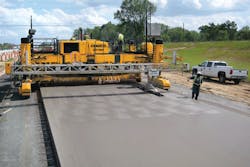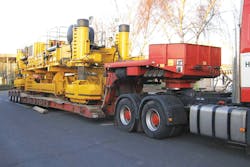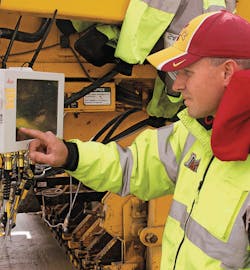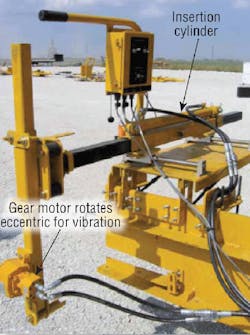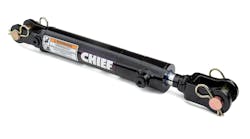The incorporation of electrohydraulics into road construction equipment continues to reduce the time and cost it takes to build streets and highways while also increasing quality of the road itself. Nowhere is this more evident than with the GHP-2800 slipform paver from GOMACO Corp., Ida Grove, Iowa. The GHP-2800’s all electronic-over-hydraulic control system makes for easy, accurate, and fast controlled response. Furthermore, the GHP-2800’s hydraulic system features a full spectrum of configurations to maximize versatility and efficiency.
For example, track circuits use a closed-loop hydrostatic pump. Vibrator circuits use open-loop load-sensing pumps, and an auger circuit uses a tandem closed-loop hydrostatic pump. In addition, the main circuit of its lift system uses an open-loop pressure-compensated pump, and a grout box auger/tamper circuit uses an open-loop load-sensing pump.
Controlling all this hydraulic power is GOMACO’s G+ proprietary software and operating system that combines intelligence with simplicity. The digital control system contains 14 function buttons and uses a graphical display for easy-to-understand icons and straightforward full-text commands in any major language. Its 61⁄2-in. anti-glare display screen provides high visibility under all operating conditions.
The control system also provides pushbutton setup for steering and trainable track steering when interfaced with smart cylinders on the four-track GHP-2800. The smart steering cylinders feature continuous electronic feedback of stroke back to the controller. This eliminates the chain, sprocket, and potentiometer used in other machines and the need for periodic adjustment and maintenance inherent to them. Steering is also versatile. Two-track models can rotate 360° on their center axis by driving tracks in opposite directions. Track drives in the four-track model can pivot 45° relative to the frame and perform two-track steering, four track, 360° steering, or crab steering.
The operating system’s pushbutton steering setup lets the operator teach the 87,000-lb machine to follow a desired degree of leg rotation so that tracks do not strike any object in minimum-clearance or zero-clearance requirements. However, the operator can override this setting.
Power and versatility
The GHP-2800 is powered by a Caterpillar C9, 8.8 l diesel engine, which develops 325 hp (242.5 kW) at 2200 rpm. The paver is available in two- or four-track versions. The two-track drive is powered by a closed-loop, tandem mounted hydrostatic pump capable of delivering up to 31 gpm to dual-speed hydraulic motors driving 202:1 geared speed reducers. The pump in the four-track model can deliver up to 45 gpm to dual-speed hydraulic motors, also driving 131:1 speed reducers. The two-track version has a track speed of 122 ft/min, and the four-track model is rated for 73 ft/min. The main hydraulic reservoir holds 180 gal of fluid for serving the multiple pumps throughout the machine.
A hydraulic fan drive powers the cooling system for the engine’s charge air, engine coolant, and hydraulic oil. A centrifugal fan, among the first to be used in the mobile equipment industry, has blades designed with an air foil shape to maximize air movement with the least amount of noise.
Thickness of the slab is controlled by varying elevation of the paver. This is accomplished by lift cylinders that control elevation of the paver chassis with respect to the drive tracks. The cylinders are fed by a 45-gpm open-loop, pressure compensated pump.
A pair of hydraulic motors drive split augers that spread concrete to a predetermined width. A tandem closed-center, hydrostatic pump provides up to 60 gpm to hydraulic motors that drive right- and left-hand sections independently with variable speed to ensure uniform distribution of concrete. A split strike-off drive works with the split augers to meter material into a paving mold, which establishes the width and upper surface of the slab. The optional detachable auger/strike-off mold and auger both have 6 ft (1.83 m) movement from telescoping cylinders to aid in changing paving width. When paving width must be changed, the contractor removes a section of the paving mold and moves the auger and strike-off in or out. A grout box auger is also powered by a hydraulic motor to control material through transitions or extreme elevations.
Vibration is a vital function that consolidates the concrete to remove air pockets and ensure uniformity. Vibration is applied to the throat area of the mold, and in the GHP-2800, vibration is controlled automatically by machine movement and powered hydraulically with variable speed up to 10,500 vibrations/min. The GHP-2800 has 16 vibration control circuits, each driven by a hydraulic motor that spins an eccentric weight. The vibration system is powered by two open-loop load-sensing pumps, each supplying 41 gpm of output flow. And if this isn’t enough, GOMACO offers eight additional vibration circuits as an option. Vibrator positioning is also controlled via hydraulics for ease in startup and finish.
Vertical hinged side plates also feature hydraulic control for ease in startup from a previously cast slab. A hydraulic cylinder’s 4-in. stroke opens or closes split side plates. This reduces labor and provides a smoother transition to the new slab. The vertical hinged side plates can also be raised or lowered by hydraulics to navigate around obstacles.
Road surfaces are usually cast with a crown, to promote rainwater runoff. However, crowning should be adjusted to avoid uneven surfaces at intersections. GOMACO accomplishes this with its powered transition adjuster (PTA). The PTA provides on-the-go transitions in the crown of the concrete slab. A switch on the operator’s console controls vertical motion to gradually reduce or restore the surface crown.
The GHP-2800 works in dirty environments. It’s no wonder, then, that it provides extensive filtration for long component life and reliable service. Its main filter is rated at 10 µm using synthetic media and with a bypass pressure of 25 psi. It also has three 100-mesh bypass suction strainers and another 10 µm synthetic media filter for the lift circuit and four charge pressure filters, all rated at 16 µm.
When the work is done, hydraulics is again called on to retract the GHP-2800 into a size that can be transported over standard highways. The two-track paver transforms into a footprint 12 ft wide and 19 ft, 3 in. long. The four-track model has a minimum transport width of only 8 ft 2 in. and length of 36 1⁄2 ft.
For more information, visit www.gomaco.com.
Tie bars on the side
Fresh slabs of concrete often need straight tie bars inserted into their sides. Inserting these bars requires a linear force, and vibration is applied to the bar to assist penetration and also help consolidate material around the bar. As with GOMACO’s GBH-2800, hydraulics is the technology of choice to get the job done.
Operation is straightforward. The operator aligns the inserter for the correct spacing of tie bars, loads a bar, then trips the Start insertion switch. This shifts a valve to start the gear motor spinning and also shifts a directional valve to initiate cylinder extension. Once the cylinder extends to a predetermined stroke, a proximity switch is tripped, which blocks flow to the motor and shifts the cylinder’s directional valve to retract the cylinder. When the cylinder fully retracts, another prox switch is tripped, which stops all hydraulic movement until the start switch is again pressed.

